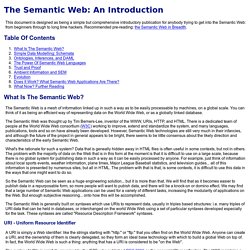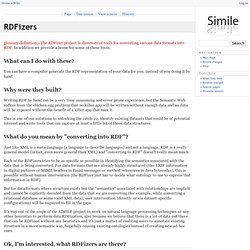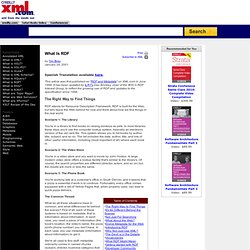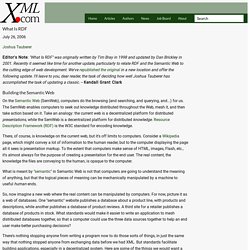

The Semantic Library: RDF In Practice. The Semantic Web: An Introduction. This document is designed as being a simple but comprehensive introductory publication for anybody trying to get into the Semantic Web: from beginners through to long time hackers.

Recommended pre-reading: the Semantic Web in Breadth. Table Of Contents What Is The Semantic Web? The Semantic Web is a mesh of information linked up in such a way as to be easily processable by machines, on a global scale. You can think of it as being an efficient way of representing data on the World Wide Web, or as a globally linked database. The Semantic Web was thought up by Tim Berners-Lee, inventor of the WWW, URIs, HTTP, and HTML. What's the rationale for such a system? RDF - Semantic Web Standards. Overview RDF is a standard model for data interchange on the Web.

RDF has features that facilitate data merging even if the underlying schemas differ, and it specifically supports the evolution of schemas over time without requiring all the data consumers to be changed. RDF extends the linking structure of the Web to use URIs to name the relationship between things as well as the two ends of the link (this is usually referred to as a “triple”).
Using this simple model, it allows structured and semi-structured data to be mixed, exposed, and shared across different applications. This linking structure forms a directed, labeled graph, where the edges represent the named link between two resources, represented by the graph nodes. Recommended Reading The RDF 1.1 specification consists of a suite of W3C Recommendations and Working Group Notes, published in 2014. RDFizers. RDFizers glossary definition:=The RDFizer project is directory of tools for converting various data formats into RDF.

In addition we provide a home for some of these tools. What can I do with these? You can have a computer generate the RDF representation of your data for you, instead of you doing it by hand. Why were they built? Writing RDF by hand can be a very time consuming and error prone experience, but the Semantic Web suffers from the chicken-egg problem that no killer app will be written without enough data and no data will be exposed without the benefit of a killer app that uses it. This is one of our solutions to unlocking the catch-22: identify existing datasets that could be of potential interest and write tools that can capture at least a little bit of those data structures.
What do you mean by "converting into RDF"? URL vs. URI vs. URN: The Confusion Continues. A year has passsed since my last post on URIs and URLs and it would seem that some of the concepts are still lost on some folks. With that said, I figured I’d throw up another post that I could try and address some of the questions raised in the comments of both posts. URLs and URNs are both URIs This is one point that can’t be stated enough. A URL is a URI and a URN is a URI, plain and simple.
It’s really quite challenging to phrase it any other way. Examples of URLs and URNs: People have also suggested that these posts could have been more helpful if I had provided some examples that illustrate the difference between a URL and a URI. Again, all of the examples above are all valid examples of URIs. There’s a very informative page by Tim Berners-Lee that provides a lot of good deails on Uniform Resource Identifiers. “The only thing you can use an identifier for is to refer to an object. When you followed the link to this page, you didn’t have to do anything other than clicking it.
No. What Is RDF? Tim Bray 2001. January 24, 2001 Spanish Translation available here.

This article was first published as "RDF and Metadata" on XML.com in June 1998. It has been updated by ILRT's Dan Brickley, chair of the W3C's RDF Interest Group, to reflect the growing use of RDF and updates to the specification since 1998. The Right Way to Find Things RDF stands for Resource Description Framework. Scenario 1: The Library You're in a library to find books on raising donkeys as pets. Scenario 2: The Video Store You're in a video store and you want a movie by John Huston. What Is RDF? Joshua Tauberer.
What Is RDF July 26, 2006 Joshua Tauberer Editor's Note: "What Is RDF" was originally written by Tim Bray in 1998 and updated by Dan Brickley in 2001.

Recently it seemed like time for another update, particularly to relate RDF and the Semantic Web to the cutting edge of web development. We've republished the original in a new location and offer the following update. Building the Semantic Web On the Semantic Web (SemWeb), computers do the browsing (and searching, and querying, and...) for us. There, of course, is knowledge on the current web, but it's off limits to computers. The Semantic Library: RDF In Practice. Main Page - Pledge. SIMILE Project. FACADE - Future-proofing Architectural Computer-Aided DEsign. Rdfneasist.